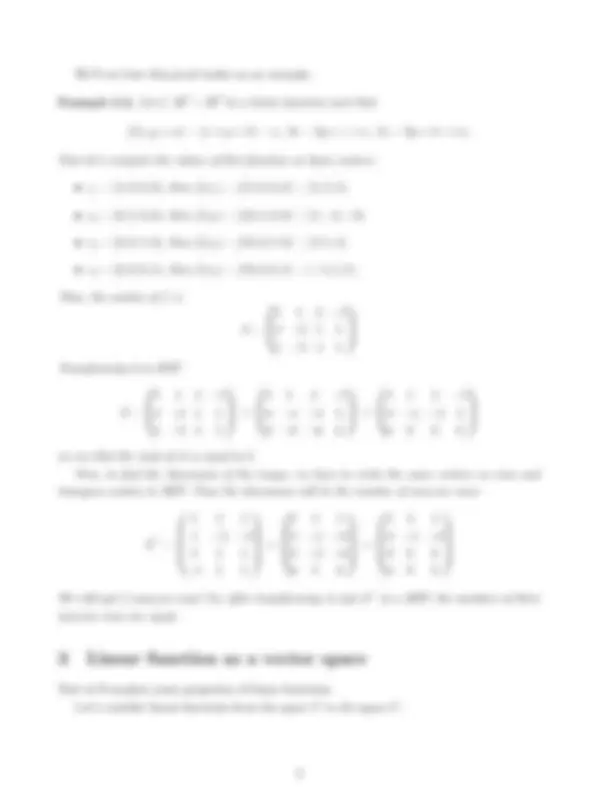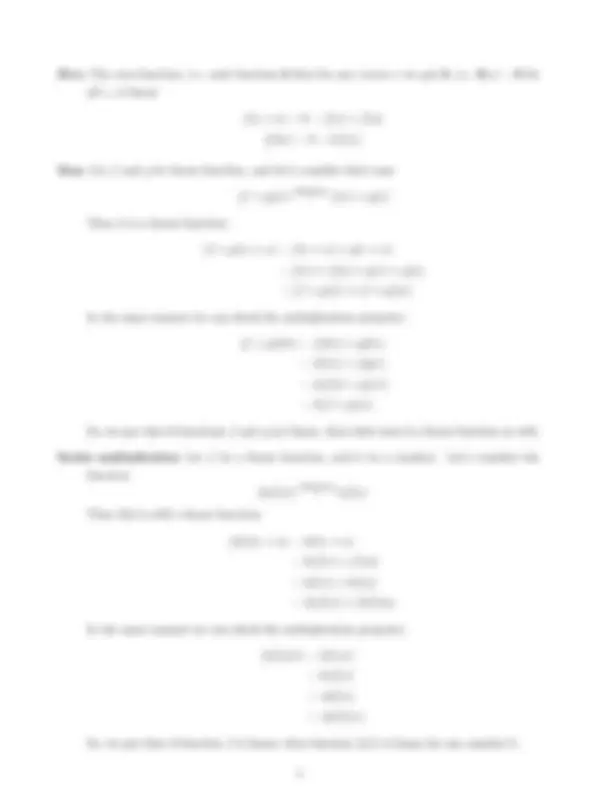





Study with the several resources on Docsity

Earn points by helping other students or get them with a premium plan


Prepare for your exams
Study with the several resources on Docsity

Earn points to download
Earn points by helping other students or get them with a premium plan
Community
Ask the community for help and clear up your study doubts
Discover the best universities in your country according to Docsity users
Free resources
Download our free guides on studying techniques, anxiety management strategies, and thesis advice from Docsity tutors
The theoretical facts about images, linear functions, and their dimensions. It covers the kernel and image of a linear function, their dimensions, and the relationship between them. The document also includes a proof of the rank of a matrix and its transpose. It is useful for students studying linear algebra, linear functions, and matrix theory.
Typology: Study notes
1 / 5

This page cannot be seen from the preview
Don't miss anything!




Now we’ll develop some theory about the image and its dimension and basis. Let f be a linear function from V to U , and dim V = n. Let’s consider the kernel of f. We can find the basis of the kernel. Let it consist of r vectors, e 1 , e 2 ,... , er. Now we can use the procedure of extending to the basis to find the basis of the whole V which contains the vectors e 1 , e 2 ,... , er. Let we added vectors from er+1 to en, so that the basis of V is
︷ basis of︸︸ V ︷ e ︸ 1 , e 2 ,... , e︷︷ r︸ basis of Ker f
, er+1,... , en
We know that the image of f is spanned by f (e 1 ), f (e 2 ),... , f (en). But f (e 1 ), f (e 2 ),... , f (er) are all equal to 0, because they belong to the kernel. So, the image is spanned by f (er+1), f (er+2),... , f (en). Now let’s prove that they are linearly independent, and then it will be proved that they form a basis for the image. To check their linear independence, let’s write the linear combination which is equal to 0:
ar+1f (er+1) + ar+2f (er+2) + · · · + anf (en) = 0.
This is the same as f (ar+1er+1 + ar+2er+2 + · · · + anen) = 0.
So, it follows that ar+1er+1 + ar+2er+2 + · · · + anen
belongs to the kernel of f. But the kernel is spanned by e 1 , e 2 ,... , en, so,
ar+1er+1 + ar+2er+2 + · · · + anen = b 1 e 1 + · · · + brer
or ar+1er+1 + ar+2er+2 + · · · + anen − b 1 e 1 − · · · − brer = 0.
So, we got a zero linear combination of basis vectors which are independent. So, its coefficients are all equal to 0, and ar+1 = ar+2 = · · · = an = 0.
Thus, vectors are linearly independent. So, we see that the dimension of the image is equal to n − r, where r = dim Ker f. So, we got the following very important theorem:
Theorem 1.1. If f is a linear function from V to U , and dim V = n, then
dim Ker f + dim Im f = n.
In our examples it was the case, since f was a function on 4-dimensional space, and dim Im f + dim Ker f = 2 + 2 = 4.
2 Application of image and kernel to matrices
In this section we’ll try to use the theoretical results about dimensions of Image and Kernel to get a nice property of the rank of a matrix. First, let’s recall, that the following equality was proved:
dim Im f + dim Ker f = n, (1)
where n is a dimension of a vector space in which the function is defined. Moreover, we derived the following formula for the dimension of the kernel:
dim Ker f = n − rk A, (2)
where A is a matrix of a linear function f. Comparing these two identities, we can easily prove, that dim Im f = rk A, (3)
where A is a matrix of a linear function f. To compute the rank of a matrix, we had to transpose it to REF, and then the rank is equal to the number of nonzero rows. Now let’s recall the algorithm of finding the dimension of the image. To find the dimension of the image, we had to write f (e 1 ), f (e 2 ),... , f (en) as ROWS of a matrix, than transpose it to REF, and the number of nonzero rows is the dimension of the image of f. But the matrix of a function is matrix with COLUMNS equal to f (e 1 ), f (e 2 ),... , f (en)! So, the matrix of a function and the matrix from the algorithm of finding the dimension of the image are transposes of each other! So, because of the formula for the dimension of the image (3), we should get the same number of nonzero rows in REF for these two matrices. Thus we proved the following beautiful theorem:
Theorem 2.1. For any matrix A rk A = rk A>.
Zero The zero-function, i.e. such function 0 that for any vector v we get 0 , i.e. 0 (v) = 0 for all v, is linear:
f (v + u) = 0 = f (v) + f (u) f (kv) = 0 = kf (v).
Sum Let f and g be linear function, and let’s consider their sum
(f + g)(v) definition = f (v) + g(v)
Then it is a linear function:
(f + g)(v + u) = f (v + u) + g(v + u) = f (v) + f (u) + g(v) + g(u) = (f + g)(v) + (f + g)(u).
In the same manner we can check the multiplication property:
(f + g)(kv) = f (kv) + g(kv) = kf (v) + f g(v) = k(f (v) + g(v)) = k(f + g)(v).
So, we got that if functions f and g are linear, then their sum is a linear function as well.
Scalar multiplication Let f be a linear function, and k be a number. Let’s consider the function (kf )(v) definition = kf (v). Then this is still a linear function:
(kf )(v + u) = kf (v + u) = k(f (v) + f (u)) = kf (v) + kf (u) = (kf )(v) + (kf )(u).
In the same manner we can check the multiplication property:
(kf )(cv) = kf (cv) = kcf (v) = ckf (v) = c(kf )(v).
So, we got that if function f is linear, then function (kf ) is linear for any number k.
So, since these 3 properties hold, we can deduce
Theorem 3.1. Let V and U be vector spaces. The set of all linear functions {f : V → U } is a vector space.
What is the dimension of it? Each linear function can be represented as a matrix, and if dim V = n, and dim U = m then this matrix is m × n-matrix. So, the dimension of the space of matrices is mn, and so is the dimension of the space of all linear functions from V to U.